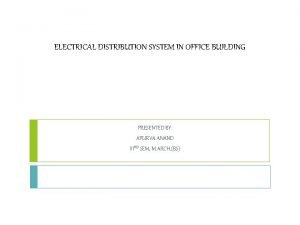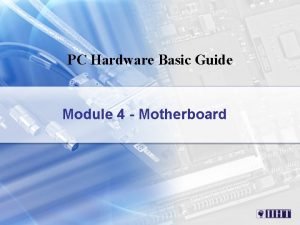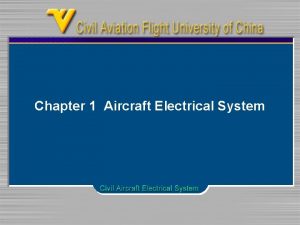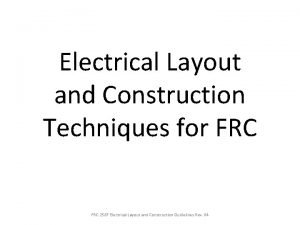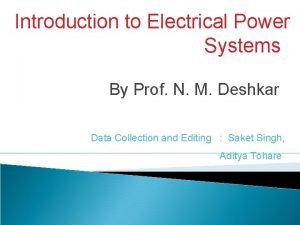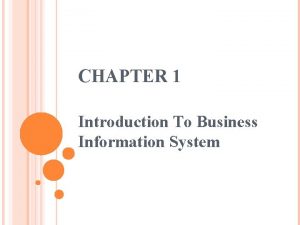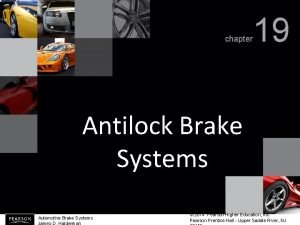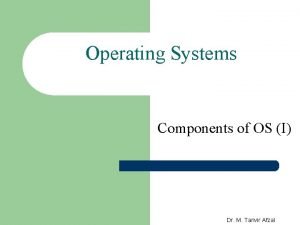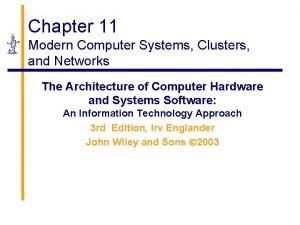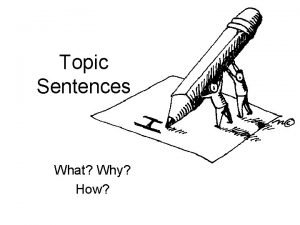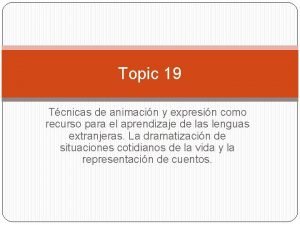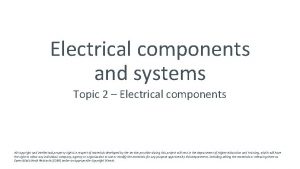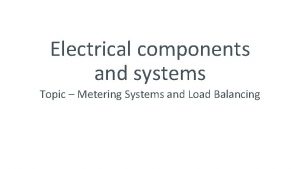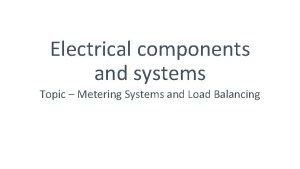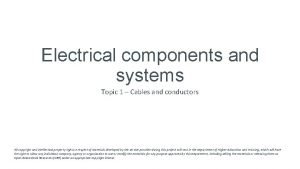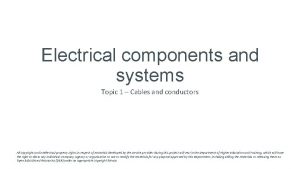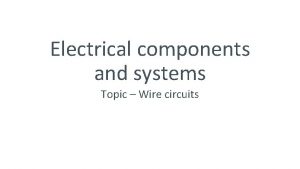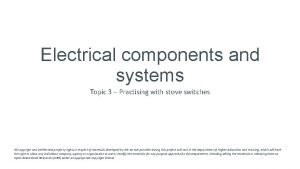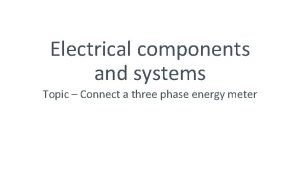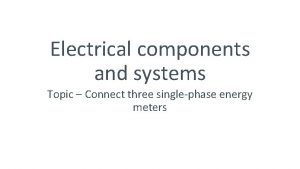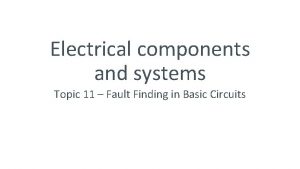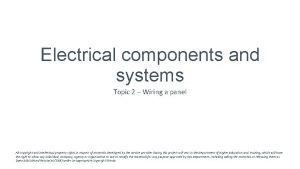Electrical components and systems Topic 4 Electrical components











































- Slides: 43

Electrical components and systems Topic 4 – Electrical components All copyright and intellectual property rights in respect of materials developed by the service provider during this project will vest in the Department of Higher Education and Training, which will have the right to allow any individual, company, agency or organisation to use or modify the materials for any purpose approved by this Department, including selling the materials or releasing them as Open Educational Resources (OER) under an appropriate copyright license.

Contactors and overloads Unit 4. 1

Assumed prior learning DC motors • Don’t feel confident yet about these topics? Click on each to review the content. • Feeling confident? Click next to proceed with this unit.

Outcomes • Function of switching devices • Purpose and function of contactors • Types of contactors • Selection of contactors • Overload protection • Purpose and function of overload relays • Types of overload protection • Selection of overload relays

Introduction An electric circuit is made up of different components or building blocks such as contactors, overload relays, fuses and circuit breakers. These are connected to each other in different ways. In this lesson we will focus on the function and use of contactors and overloads.

What is a switching device? A switching device opens and closes an electrical circuit. Electrical circuits must form a continuous loop, a switch is like a gate in that loop. A circuit is ‘on’ when the switch is closed and the circuit is ‘off’ when the switch is open. According to the SANS wiring code, contactors , fuses, circuit breakers, relays and disconnectors are examples of switching devices.

Motor components A Starter, controls electrical power use in a motor or motor controlled equipment. Starters ‘start’ motors and can also stop, reverse and protect them. Starters have two main components, contactors and overload protection. Contactors with overload protection devices are often used to start motors. Contactor Thermal overload relay

What is a Contactor? A contactor can be used on its own as a power control device or as part of a starter. Contactors are found in most electrical equipment, that is frequently turned on and off, from lighting to heating devices and complex industrial equipment. Functions of contactors

Lighting contactor In large office buildings or shopping centres for example, lighting contactors are used to provide central, remote control of the large number of lighting installations. In a home, a light switch is an example of a switching device.

Difference between contactors and relays Both contactors and relays perform the task of switching a circuit BUT they have very different applications. The main differences between them are the loads they are designed to carry and the amount of power each uses. • Contactors are used for high voltage switching so they have much larger electromagnets that draw significant amounts of power. • Relays are used for low voltage switching hence the smaller electromagnets require much less power than contactors.

Contactor components A contactor has three main parts: • The contacts, which are the current carrying parts of the contactor made up of the power contacts, auxiliary contacts and contact springs. • The electromagnet, which provides the force to close the contacts. • The enclosure, which is the frame that houses the contacts and electromagnet. Click on each component in the figure to learn more.

How the armature works In the construction of a contactor, the armature is connected mechanically to a set of contacts. When the armature moves to the closed position, the contacts close or open depending on their characteristics. There are three types of armature assemblies: Clapper, Vertical action and Bellcrank.

Clapper type armature

Vertical action armature

Bellcrank type armature

Shading rings A shading ring is a single turn of copper mounted on the face of an electromagnet assembly or the armature.

Selection of contactors It is important that the correct contactor is selected for specific loads and applications. When replacing a contactor, look at both the current and application markings on the contactor. Vid 01=Selection of contactors for specific loads and applications

After watching Video 01: selection of contactors, answer the questions that follow.

Question 1 What is the function of a contactor? a) b) c) d) To manually operate starters Motors are controlled with the aid of contactors Control sequencing device To open and close contacts electromagnetically

Question 2 Which contactor is suited to the load in printing machines? a) b) c) d) AC-1 AC-2 AC-3 AC-4

Question 3 Label the diagram below correctly. Choose the correct labels from the list on the right and drop them onto the corresponding positions in the diagram. Pivot point A B Armature Stationary contacts E Coil D CC Moving contacts

How is a motor protected? Motor protections vary according to the size of the motor and voltage level. SANS Regulation 6. 7. 1. 1 states that protection against overload and short-circuit may be provided by separate devices or by a single device. One such device is the overload relay. Protective devices must operate at currents and voltages and within timeframes that are related to the characteristics of the circuit that they serve.

Overload relays An overload relay protects an electrical motor from overheating once an overload is detected. When current is too high for too long, heaters cause the relay contacts, carrying current to the coil of the contactor, to open. When the contacts open, the contactor coil de-energizes, which results in an interruption of the main power to the motor.

Type of overload relays When current flows in a conductor, heat is generated and a magnetic field is set up around the conductor - both being proportional to the amount of current flowing. Overload relays make use of either the magnetic effect or thermal effect of the current flowing in the power circuit. SAFETY FIRST !

Magnetic overload relays Magnetic forces are used to operate some form of tripping mechanism to trip the starter. Magnetic relays are usually set to trip at 100% of motor rating. Magnetic overload relay

Key points on magnetic overload relays • The deeper the plunger in the coil, the weaker the field needed to draw it into the coil. • When the plunger is in its correct position and normal current is flowing, the magnetic force will be too weak to draw the plunger into the coil. When the current is increased due to an overload, the magnetic field becomes stronger and draws the plunger deeper into the coil. The plunger strikes the trip pin, which in turn trips the switch. • The position of the plunger in the coil determines the current that will trip the starter.

Thermal overload relays There are two types of thermal overload relays: Bimetallic overload relay Eutectic alloy type overload

Example: Thermal protection Mrs Edwards is vacuuming her floors when suddenly the vacuum cleaner switches off. She tries to switch the machine on again but nothing happens, when she touches the vacuum cleaner she notices that it is very hot. After a few minutes, when the machine has cooled down, she is able to continue with the vacuuming. Explain the possible cause and reason for the machine switching itself off. INSERT ANSWER HERE AND PRESS ENTER WHEN DONE

Functions of overload components The overload components are: • Terminals (power circuit) • Current adjustment • Reset button • Trip switch terminals (control circuit) Vid 02=Functions of overload components and selection of overloads

Quiz time We have come to the end of this unit. Answer the following questions to make sure you understand how to work with overload protection.

Question 1 What type of overload relay is shown in the figure below? a) b) c) d) Thermal Magnetic Eutectic alloy type Bimetallic

Question 2 Label the overload relay correctly. Choose the correct labels from the list and drop them onto the corresponding positions in the diagram. Tripping contacts Current setting range Signaling contacts Terminals (1 L 1, 3 L 2, 5 L 3) RESET button Terminals (2 T 1, 4 T 2, 6 T 3) STOP button Status indicator

Question 3 Overload current is defined as the current that flows when a short circuit occurs. TRUE Click on the correct answer. FALSE

Question 4 The main difference between a contactor and a relay is a contactor : a) b) c) d) Only works on AC power Only has one set of contacts Controls larger currents Controls voltage only

Question 5 What is the part labelled X in the diagram called? a) b) c) d) Adjustable washer Eutectic alloy Bimetallic strip Guide bush X

Let’s review: In this lesson we have covered: üIdentifying different types of contactors. üSelecting contactors for different loads. üTypes of overload relays. üFunctions and selection of overload relays. Make sure you have a complete understanding of all the work covered here before you start the next unit.

Video brief - Vid 001 Expert technician explaining: Selection of contactors for specific loads and applications (NB: Presenter must be able to explain the in-rush current diagrams) It is important that the correct contactor is selected for specific loads and applications. Contactor ratings are clearly marked on the contactor, but care must be taken to select the correct contactor, based on current and application. Remember: When replacing a contactor, look at both the current and application markings on the contactor. The load type and duty cycle of the load are known as the Utilisation Category. There are basically four utilisation categories of contactors, denoted AC-1, AC-2, AC 3 and AC-4. The categories are determined by the current values that the contactor must make (switch on) or break (switch off), and they depend on: • The type of load being switched for example squirrel cage or slip ring motor, resistors. • The condition under which opening and closing, that is breaking and making of the circuit is performed, like motor running or stalled or in the course of starting or reverse running. Making capacity is the current capacity of the breaker, which it can handle during closing even if the line has a short circuit fault. Breaking Capacity is the current capacity of the breaker, which it can handle during opening. This will be less than the Making capacity.

Video brief - Vid 001 contin. Expert technician explaining: Selection of contactors for specific loads and applications Voice over Image In the 3 phase Squirrel-cage inductive motor load, which is one of the most common load types in the industry, the motor draws a significant amount of current (inrush current) when starting. Squirrel cage and slip ring motors are discussed in detail in unit 6; DC motors. The inrush current during the start of the motor is significantly higher than the motor running current. This can be seen in this chart. The contactor will have to be able to withstand this current. Category AC-1 We can summarise the four utilisation categories as; AC-1, AC-2, AC-3 and AC-4. The charts you are about

Video brief - Vid 001 contin. Expert technician explaining: Selection of contactors for specific loads and applications Voice over Image Category AC-2. Applies to starting, plugging and Category AC-2 inching of slip ring motors. On closing, the contactor makes the starting current, (approximately 2. 5 x Ie). On opening, it must break the starting current (voltage ≤ mains voltage). Breaking is severe. An example of this is Lifting overhead cranes, gantries. Application example: Lifting overhead cranes, gantries.

Video brief - Vid 001 contin. Expert technician explaining: Selection of contactors for specific loads and applications Voice over Image Category AC-3. This applies to squirrel cage motors where breaking occurs while the motor is running. On closing, the contactor makes the starting current, which is about 5 to 7 times the rated current of the motor. On opening, it breaks the rated current drawn by the motor. Examples of this include; Conveyor belts, compressors, pumps, mixers, and air conditioning units. Category AC-3 Application example: Conveyor belts, compressors, pumps, mixers, and air conditioning units.

Video brief - Vid 001 contin. Expert technician explaining: Selection of contactors for specific loads and applications Voice over Image Category AC-4. Applies to plugging and inching of squirrel cage motors. The contactor makes the starting current, (approx. 5 to 7 x Ie). On opening, it breaks this same current, which varies according to motor speed. Breaking is severe. Application examples are: Hoists, printing machines, wire drawing machines. Category AC-4 Application example: Hoists, printing machines, wire drawing machines.

Video brief - Vid 02 Expert technician explaining the function of overload components and selection of overloads An overload relay protects an electrical motor from overheating once an overload is detected. When current is too high for too long, heaters cause the relay contacts, carrying current to the coil of the contactor, to open. When the contacts open, the contactor coil de-energizes, which results in an interruption of the main power to the motor. • We will examine the following components on the overloads display board. Terminals (power circuit) • Incoming connectors are in the form of adjustable copper prongs or screw type terminals. These terminals or prongs are connected to the contactor terminals and are marked in the same manner as the contactor top stationary contacts (1, 3, 5; R, S, T; L 1, L 2, L 3). Outgoing connectors are in the form of screw type terminals. These terminals connect the load to the power circuit and are marked the same as the contactor bottom stationary contacts (2, 4, 6; U, V, W; T 1, T 2, T 3). Current adjustment • Adjustment of the overload relay to match the full load current of the load can be by means of either a lever, a screw or heater coil. The lever is moved to the desired current mark. The screw works as a dial graduated in amperes. The heater coil works against a standard selection table. For a certain current rating, a heater coil has to be chosen from a chart to match the load current and it must be installed on the overload. Reset button • A hand/auto lever or screw provides selection of either manual resetting of the trip switch by the insulated stopreset push, or automatic resetting of the trip switch when the relay has cooled after tripping. Trip switch terminals (control circuit)

Video brief - Vid 02 contin. Expert technician explaining the function of overload components and selection of overloads Selection of overloads After determining the full load current, it is important to select an overload that suits the contactor and the load. Remember overloads can be connected directly beneath the contactor or separately. Ensure that the range of current settings, which are marked on the overload, accommodates the full load current. In the case of a heater coil overload, ensure that the heater coils will be able to handle the full load current. According to SANS Code of Practice for the Wiring of Premises an overload protective device shall be installed a) along a conductor where the current capacity of the conductor is reduced, b) where thermal rating of a disconnecting device could be exceeded (summation of ratings), and c) where thermal rating of an earth leakage protection device not provided with integral overcurrent protection, could be exceeded. Make sure that you are able to select the correct overloads for different loads. Overload relays are inexpensive, but the results of selecting the wrong one for an application can be a disaster for your motor, process, or both.
 Examples of clinchers
Examples of clinchers Topic down
Topic down Topic 2 free enterprise and other economic systems
Topic 2 free enterprise and other economic systems Types of electrical rising main
Types of electrical rising main Module 4 topic 2 components of the space management system
Module 4 topic 2 components of the space management system Supporting sentence 2
Supporting sentence 2 Module 10 topic 2 vehicle malfunctions
Module 10 topic 2 vehicle malfunctions Decision support systems and intelligent systems
Decision support systems and intelligent systems Aircraft electrical components
Aircraft electrical components Frc electrical components
Frc electrical components Mathematical modeling of electrical systems
Mathematical modeling of electrical systems Introduction to electrical power systems
Introduction to electrical power systems One electrical systems
One electrical systems Components of an operating system
Components of an operating system Components of operating systems
Components of operating systems File management in operating system
File management in operating system What is information
What is information Types of media systems
Types of media systems Cross section of antilock braking system components/systems
Cross section of antilock braking system components/systems Components of operating systems
Components of operating systems Information system 5 components
Information system 5 components Computer systems components
Computer systems components Engineering elegant systems: theory of systems engineering
Engineering elegant systems: theory of systems engineering Embedded systems vs cyber physical systems
Embedded systems vs cyber physical systems Elegant systems
Elegant systems Give at least 5 tools in making simple electrical gadgets
Give at least 5 tools in making simple electrical gadgets Supporting sentence
Supporting sentence Topic 15 periods authors and genres
Topic 15 periods authors and genres Topic and closing sentences
Topic and closing sentences How to write a topic sentence
How to write a topic sentence Topic sentence
Topic sentence Infiltration water cycle
Infiltration water cycle Topic 7 economic performance and challenges
Topic 7 economic performance and challenges Expresin
Expresin Landscape development and environmental changes
Landscape development and environmental changes Earth's dynamic crust and interior topic 12
Earth's dynamic crust and interior topic 12 Transition thesis
Transition thesis Announcement topic sentence
Announcement topic sentence Central idea vs main idea
Central idea vs main idea Romeo and juliet topic sentence
Romeo and juliet topic sentence Paragraph using phrasal verbs
Paragraph using phrasal verbs Is the main idea the theme
Is the main idea the theme Introduction hook background thesis statement
Introduction hook background thesis statement Barry liked playing board games
Barry liked playing board games



